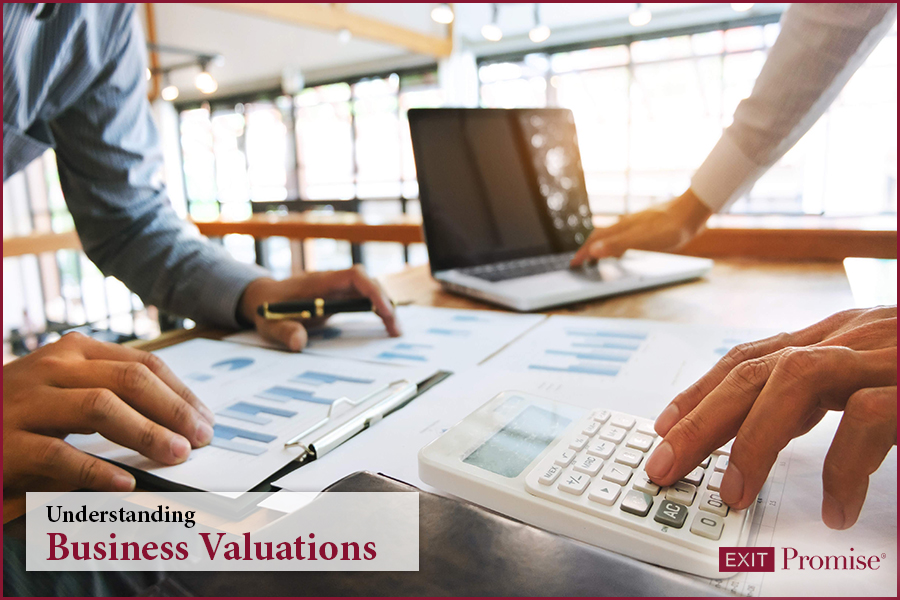- EBITDA Add Backs and Adjustments - February 20, 2023
- The Three Business Valuation Approaches [Infographic] - November 1, 2022
- The Negative Effect of Concentrations on the Value of a Business - August 17, 2022

Quite simply, a business valuation is a process and set of procedures used to determine what a business worth.
Sounds unambiguous, right? But it takes more than just plugging numbers into a formula — a credible business valuation requires knowledge, preparation, and a thorough understanding of the business.
The result is an objective assessment of the real value of the business. In addition to estimating the selling price of a business, a business valuation can be used for many legal purposes such as divorce litigation, shareholder disputes, and estate or gift taxation.
What is Business Value?
The term business value is a broad term that refers to any form of business valuation which determines the financial health and potential of a company.
While a purchase or selling price is simply an amount that may be asked to be paid for 100% ownership of a given business, the intrinsic value of the business is a larger picture representation of what a purchaser or shareholders may expect to receive financially as a result of ownership.
Assumptions in business valuation may drive results
There are several ways to measure business value. Why? Because business value is seen differently by different people.
For example, a business owner may believe that their business is worth its intrinsic value. On the other hand, a private equity investor may assess a business solely on its ability to generate a profit.
Business value constantly changes. Positive changes in market conditions and a company’s strong financial performance will drive up the perceived value of the business. And when the market changes for the better there is almost always an increase in the number of potential investors. Thus, driving up selling prices.
Business Value can vary greatly depending on who will benefit from the analysis. For example, an entrepreneur seeking a business to fulfill personal goals will have a very different perspective than an investor looking for maximum financial growth potential, or a business owner looking to expand their portfolio of businesses.
Similarly, a competing business will value a business at a higher level for reasons such as synergies in resources and operations, administrative cost reductions, and increased market share opportunities post-acquisition.
In short, the market is the ultimate test of business value. But relying only on the market to determine the value of a business is ignores some basic principles. How the company is marketed to potential investors is essential to achieving the highest selling price.
Three business valuation approaches
By definition, a business valuation is a computational procedure used to determine the value of a business. In fact, there are three:
- Asset approach
- Market approach
- Income approach
Asset approach
Under the asset approach a valuation analyst adopts the view of a business as a set of assets and liabilities. The balance sheet elements serve as building blocks to create a picture of business value. The main asset valuation methods are:
- Capitalized Excess Earnings Method
- Asset Accumulation Method
The Capitalized Excess Earnings method uses complex formulas to calculate the value of a business as the sum of its tangible assets and business goodwill.
The formulas for the asset accumulation method are a set of adjustments applied to the business’s assets and liabilities.
When determining the market values of the business’s assets and liabilities it vitally important to include off-balance sheet items such as intangible assets and any contingent liabilities.
Market approach
Under the market approach a valuation analyst looks for signs from the real marketplace to figure out what a business is worth. The economic principle of competition is inherent.
The market approach to business valuation is a quick and simple way to determine a business’s fair market value. The methods under the market approach use valuation multiples, or ratios, that relate the business market value to some measure of the business’s economic performance. Valuation multiples are derived from the actual selling prices of similar, but not identical, businesses that have recently been sold.
Income approach
Under the income approach a valuation analyst calculates business value based on the business’s expected future earnings and risk. There are two main methods under the income approach:
- Capitalization methods
- Discounting methods
Depending on the method chosen the business valuation formula will differ. For example, the capitalization method divides earnings by a capitalization rate or earnings multiplier. The idea is that the business value is defined by business earnings and the capitalization rate is used to relate the two. The capitalization rate works very well for businesses with a steady stream of cash and predictable earnings.
On the other hand, the discounting method requires a projection of future cash flows which is then converted into present day dollars by applying a discount rate. Then a discount rate is determined which captures the risk of getting the projected income on time and in full.
The underlying assumption for the discount method is that the business will continue in perpetuity, therefore the business has what is known as a terminal value. By applying the discount rate to the forecasted earnings and then multiplying by the terminal value results in the present value of the business.
Business valuation reports
By definition, a business valuation report is a document detailing the scope, key assumptions, business valuation methods, and conclusions of a business appraisal agreement or calculation engagement.
The difference between the two versions of the business valuation report is the content and level of information provided. The appropriate report option and the level of information necessary in the reports are dependent on the intended use and the intended users.
Detailed appraisal
The objective of a detailed appraisal report is to express an accurate value of the business and an unambiguous opinion of value. Typically, all valuation methods that are relevant to the situation are applied. This type of appraisal is recommended if the valuation is intended to be used in court or for tax purposes. The results are expressed as a single amount.
Appraisals and appraisal reports of this nature must conform with the Uniform Standards of Professional Appraisal Practice.
Calculation report
The objective of a calculation report is to provide an approximate range of value based upon the performance of limited procedures agreed upon by the analyst and the client.
This report is an abridged version of a detailed appraisal report and typically excludes detailed analysis of the business and the industry. The distribution of a calculation report is limited only to the client.
A calculation report is often used for internal planning purposes such as the sale or acquisition of a business interest, business planning, succession, and estate planning.














When purchasing a franchise, that isn’t doing a lot of business as owner has scaled back on time and marketing commitment, how is the value determined? The models mention seem more applicable to a non-franchised business.
Hi Jeffrey,
When determining the value of a business — whether it’s a franchise or not — its revenue trend is a key factor. If the revenue is decreasing year-over-year, then the value of the business will be less than if the revenue trend is stable or increasing.
All the best…
Hi,
I hope you can help.
My business partner (50/50) wants me to buy him out and he’s claiming the business is worth way more than I would pay for it.
Our revenue is $2.1 million and the net profit last year was $320,000 after we took out our salaries.
He claims the business is worth $2.1 million and wants me to pay off our bank loan before he’ll sell his half to me.
What do you think?
Hi Thomas,
When a closely-held, small business is owned by more than one person, the first place to look to determine how a business should be valued for a buy-out is the written agreements in place already.
Hopefully, you and your business partner have such an agreement in place which you can refer to. In most partnership agreements and LLC Operating Agreements, the way in which a business is to be valued in a partner buy-out is defined.
And in many cases, a cross-purchase agreement is in place for situations such as yours.
With all that said, if none of these agreements have been made by you and your business partner, it may be necessary to have a business valuation prepared.
In a closely-held business, such as yours, there are many factors which will have an important impact on the value of your business beyond the gross revenue and net profit of the business. Albeit, gross revenue and net profit is very important when determining the value of your business!
If you need assistance with your situation, we have advisors able to help you. All the best Thomas…